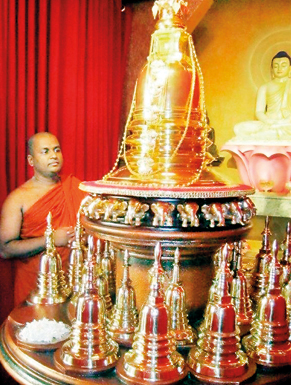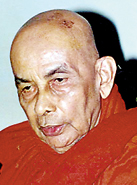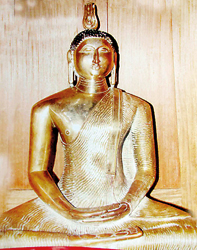A new look for the Narada Centre
Walk down Sarana Road off Bauddhaloka Mawatha. Passing the Otters Club, on the left one will notice a total change in landscape. At the Narada Centre is a newly built chaitya, a ‘dhatu mandiraya’ (Chamber of Relics) and a ‘bodhiya’ – the key elements of a Buddhist temple for the devotees to worship and meditate.
Taking the initiative in the project was Venerable Talalle Chandakitti, the energetic young monk who has, over the past few years, gradually built up the Centre as a place of Buddhist learning. In addition to the full day Poya programmes, he started conducting a weekly Dhamma class discussing a sutta every Thursday, which is well attended. Just eight months ago he announced that there were plans to provide facilities for the devotees to offer flowers at a ‘chaitya’, pay homage to the Buddha in an image house and pay respects to the ‘bodhi’ symbolising the attainment of Enlightenment. He was keen to have the work completed on time for the ‘katina pinkama’. Chandakitti Thera worked tirelessly to meet the target date.

Ven. Chandakitti at the dhatu mandiraya
And he achieved it. Amidst cries of ‘sadhu’, ‘sadhu’, the Most Venerable Tiricunamale Ananda Anu Nayaka Thera placed the pinnacle on the ‘chaitya’ at the auspicious hour of 7.14 on November 3 and launched a series of religious events to mark the opening of the ‘Narada Bauddha Dharmayatanaya’ as the Centre has now been named. It was earlier the Narada Buddhist Research & Information Centre set up on a concept by the Most Venerable Madihe Pannasiha Maha Naaka Thera to propagate the Dhamma around the world. Venerable Professor Dhammavihari and Venerable Mettavihari attended to the task with diligence using the internet to disseminate information and build a network of students of Buddhism from nations throughout the globe. With the passing away of Venerable Dhammavihari, his brother monk continues the work on a lower scale.
After the pinnacle laying ceremony, the formal opening of the ‘chaitya’ and the ‘dhatu mandiraya’ was done the same afternoon. Officiating at the function was the Most Ven Davuldena Nanissara Maha Nayake Thera, Chief Prelate of the Amarapura Chapter. Housed in a well carved gold plated casket are several relics of the Buddha and Arahants. Around it are replicas of the casket signifying the twenty eight Buddhas.
On the side are several Buddha statues with a main statue in the centre. Four smaller ones depict four different ‘mudras’ (gestures) – ‘abhaya’ (protection), ‘bhumi sparsha’ (touching the earth symbolising the defeat of Mara), dhammacakka’ (teaching) and ‘samadhi’ (meditation).
At a simple ceremony, the planting of the bo-sapling was done on November 10 at 7.18 in the morning. The sapling is from the Ananda Bodhi in Jetavanarama, the famous monastery in Sravasti, India where the Buddha resided for the better part of His life after Enlightenment.
To delve into the history of the famous Ananda Bodhi, the story goes that Buddha sanctioned the planting of a seed from the Bodhi tree in Bodhgaya in front of the gateway of Jetavana monastery so that the devotees might make their offerings in the name of the Buddha when it was not in residence.
Venerable Ananda, the Buddha’s favourite attendant asked Venerable Moggallana upon whom the Buddha had conferred the exalted position of the second disciple (the first being Venerable Sariputta), to pick a fruit from the great Bodhi tree. He held a fruit before it dropped from the stalk and handed it over to Venerable Ananda who, in turn gave it to Buddha’s principal lay disciple Anathapindika. It was planted in a gold jar with great pomp and ceremony and it is said that a sapling immediately sprouted fifty cubits high. In order to consecrate it the Buddha spent one night under it, in meditation. This tree, because it was planted under the direction of Venerable Ananda, came to be known as the Ananda Bodhi.
The sapling from the Ananda Bodhi planted at the newly constructed temple has a protective structure in the shape of an alms bowl used by monks.
That evening an all-night pirith ceremony was held in the premises. It was planned to coincide with the annual ‘katina pinkama’ which was held the following morning.
The meticulous planning by Chandakitti Thera is seen as one looks round. There is a separate place to light the ‘pol thel pahan’ and joss sticks. Water on tap is provided to wash one’s hands and to sprinkle water on the flowers. He prefers only white flowers being offered. Flower beds are already in bloom for anyone to pick flowers to offer, showing the monk’s forward thinking. A big dust bin has been erected in a corner so that the premises are kept clean, neat and tidy.
The monk makes one plea. “Take care in watering the bo sapling. Too much water will ruin it. And please don’t start hanging flags on the branches.” Both are practised either as appeals for favours or to fulfil vows.
The successful completion of the project brought in a deep sense of satisfaction to Venerable Chandakitti. It was a dream come true for the devotees.
Follow @timesonlinelk
comments powered by Disqus





















